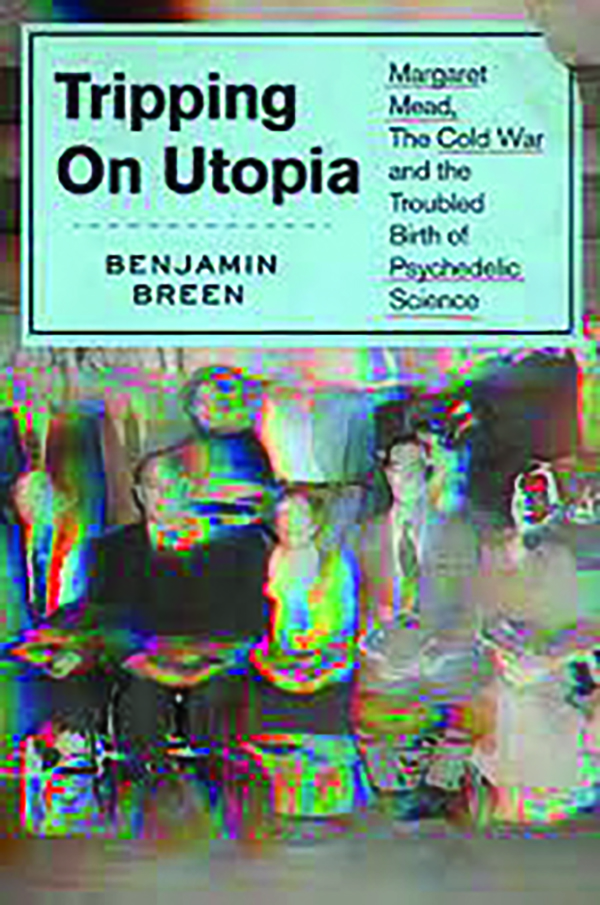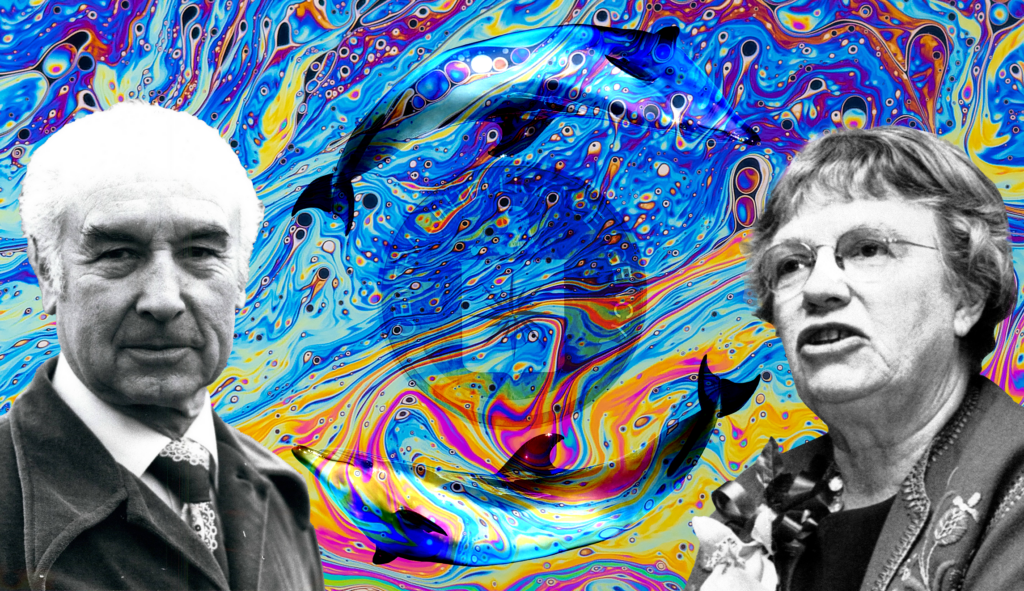The famous Dupont slogan “Better Living Through Chemistry” was never intended to apply to drug use, but as Benjamin Breen explains in Tripping on Utopia, his charming and highly readable history of the rise and fall of psychedelic substances in the United States and abroad, it might as well have been.

A historian of science at the University of California, Santa Cruz, Breen seeks to “uncover the secret history of the first wave of psychedelic science, a radical field that sought to harness the power of psychedelic substances to explore human consciousness, pioneer groundbreaking therapies, and even transform global society.”
Much more than a bunch of stoners, the midcentury exponents of drug experimentation were respected scientists seeking to make the world a better place. The so-called Macy circle, funded by the Josiah Macy Jr. Foundation over two decades, comprised psychologists, anthropologists, neuroscientists, pharmaceutical researchers, and even proto-computer scientists.
Primus inter pares was Margaret Mead, the celebrated cultural anthropologist who studied at Columbia under Ruth Benedict and Frank Boas, scholars committed to remaking human society through what Breen labels “a science of expanded consciousness.” In the late 1920s, after obtaining her degree, Mead, whom local papers dubbed a “girl ethnologist,” traveled to the Great Plains and then to New Guinea to study native tribes and their use of hallucinogenic substances.
“It works in your brain and makes you see things you never think of,” Mead recorded an Omaha man named George Phillips telling her about peyote. “Sometimes it makes you see 25 or 50 years in the future.” We now know that mescaline, the active chemical in peyote, blocks serotonin receptors in the frontal cortex, thereby altering our perception of time and control over our emotions. In the cactus-derived drug, Mead saw an opportunity to expand our understanding of ourselves.
But it wasn’t until Mead arrived in New Guinea in 1931 that she “came to see herself as a scientist who would not just study, but would push forward the limits of human consciousness.” She began to develop a grand theory of personality, society, culture, and individualism that tracked the tribal practices she discovered. One such group, the Arapesh, governed themselves through a flattened cooperative that contributed to what Mead called a novel “plane of consciousness.”
When World War II broke out, Mead returned to the United States, and the nascent Office of Strategic Services, or OSS, collaborated with the Macy Foundation in 1942 to organize the first “conference on cerebral inhibition,” designed to study and promote hypnosis. Milton Erickson, a prominent hypnotist, participated, as the OSS dreamed of a Manchurian Candidate-like scenario of capturing German POWs and reprogramming them to assassinate Hitler. One research avenue involved the “truth drug” sodium amytal, which was tested on human subjects, as was THC, the active ingredient in cannabis.

In parallel, two Macy-funded Army psychiatrists began to experiment with administering pentothal, a hypnotic drug, to traumatized GIs. Along with talk therapy, they found they could transform the soldiers’ “malignant cycles” into “benign cycles” through a process they called narcosynthesis. When the war ended, Mead’s then-husband, Gregory Bateson, who’d been recruited by OSS, campaigned for the creation of a new intelligence agency dedicated to unconventional warfare.
And yet, at the same time, both Mead and Bateson argued vociferously at the outset of the Cold War for forging a single world state, with Bateson exhorting scientists to promote “higher orders of awareness” through the inauguration of a global federation with “large scale propagandic and educational functions … from flags and parades to postal services and epidemic control” — essentially, Breen’s titular utopia.
Psychedelics beyond mescaline, sodium amytal, and cannabis were also advancing. In 1943, Swiss chemist Albert Hofmann synthesized lysergic acid diethylamide from a fungus named “ergot” and, apparently accidentally, exposed himself to its effects. Hofmann described the experience as “a not unpleasant intoxicated-like condition. … I perceived an uninterrupted stream of fantastic pictures, extraordinary shapes with intense, kaleidoscopic play of colors.” By the end of the decade, the Swiss pharmaceutical giant Sandoz was shipping LSD across the globe.
Boston Psychopathic jumped on the acid bandwagon when Dr. Robert Hyde, who became the first American to take LSD, began treating patients with it. Hyde, along with Dr. Harold Abramson, participated in various secretive CIA-sponsored programs, such as MKULTRA, that explored deploying the drug on Soviet agents in order to turn them or to drive them crazy. After these efforts bore little fruit, Abramson began collaborating with Mead on civilian applications of LSD designed, in Mead’s terminology, to empower patients to “reorganize” themselves mentally.
The high water mark of the LSD craze likely arrived in 1959, when the legendary actor Cary Grant credited his regular acid trips with his Hollywood success. That same year, the ambassador, congresswoman, and Nixon confidante Clare Boothe Luce publicly praised the drug’s effects on her otherwise troubled mental health. Her husband, publishing magnate Henry Luce, sang LSD’s virtues in the pages of Time and Life.
Meanwhile, Bateson, who had divorced Mead and moved to San Francisco, operated a psychedelic practice of his own that, by the late 1950s, had brought him into contact with the dystopian novelist Aldous Huxley, the Beat poet Allen Ginsberg, and a young psychiatrist from Boston named Timothy Leary. During and after visits to Mexico, Leary began experimenting on himself and on patients with both acid and magic mushrooms, which, when consumed, released psilocin, a chemical that stimulates neuroreceptors involved in memory retrieval. Ginsberg would later recall tripping visitors to Leary’s home as “all so cheerful and optimistic and convinced that their kind of environment would be welcomed as a polite, scholarly, socially acceptable, perfectly reasonable pursuit.”
But Leary too often got high off his own supply, suffering a predictable reversal in 1963 when Harvard University shuttered his clinic amid allegations of abuse and exploitation. Members of the Macy group distanced themselves from Leary, criticizing him and his cohort for, among other things, “administer[ing] the drugs to themselves” in addition to patients and for becoming “enamored of the mystical hallucinatory state.” And Abramson rapped Leary’s “short cut to Nirvana for the millions.” At a Senate hearing a few years later, he testified, incoherently, that “the so-called peril of LSD resides precisely in its eerie power to release ancient, wise, and I would even say at times holy sources of energy.”
Bateson’s research career, too, began to spiral after he joined a lab in the Virgin Islands that injected LSD into dolphins in a bizarre effort to study brain anatomy. He then allied himself with a collective of radicals that included Angela Davis and other Black Power luminaries. He drifted into environmental activism, away from research and under the sway of psychedelics. “Under LSD,” he said in the late 1960s, “I have experienced the disappearance of the division between self and the music to which I was listening.”
By the 1970s, most mind-altering substances had been banned by federal and state governments, Leary was behind bars, and the CIA’s covert drug programs had been exposed — and vilified. Tranquilizers, antidepressants, synthetic opioids, and stimulants had supplanted psychedelics among mental health professionals. Those once lauded as bold pioneers were now denigrated as potheads, acid-trippers, and junkies. But they would apparently have the last laugh.
“Today,” Breen reckons, “in a new era of global crisis and amid the threat of a new cold war, the same drugs are back.” Indeed, micro-dosing of LSD and other hallucinogens has trended, MDMA proliferates at clubs and concerts, and most states have legalized or decriminalized marijuana. Psychiatrists, under tight controls, have treated patients with mushrooms, ketamine, and other once-taboo drugs. The brave new world promised in the 1940s may have taken longer than expected, and it may not have ushered in utopia. But it seems to have arrived.
CLICK HERE TO READ MORE FROM THE WASHINGTON EXAMINER
Michael M. Rosen is an attorney and writer in Israel and a nonresident senior fellow at the American Enterprise Institute.
